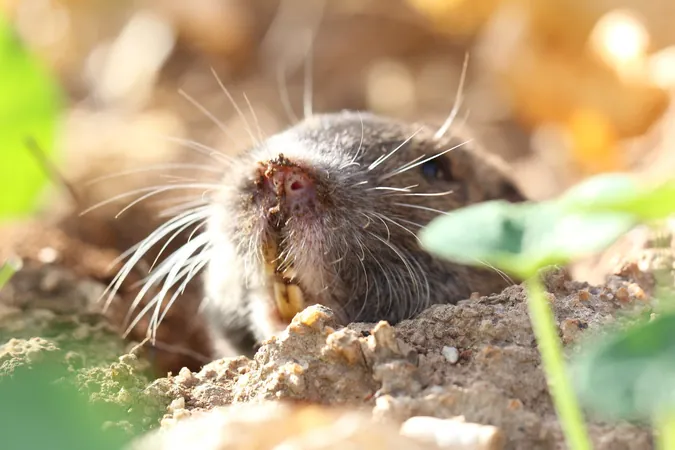
How Gophers Revived Life on Mount St. Helens: A Groundbreaking Experiment
2024-11-11
Author: Ting
Introduction
In the aftermath of one of the most catastrophic volcanic eruptions in U.S. history, scientists devised an unexpected method to restore life to the desolate slopes of Mount St. Helens: they enlisted the help of gophers. Four decades later, the lasting effects of this innovative intervention are still evident, showcasing the remarkable resilience of life.
The Eruption and Initial Conditions
On May 18, 1980, Mount St. Helens unleashed over 540 million tons of ash, blanketing a staggering 22,000 square miles and decimating local ecosystems. A few years later, researchers embarked on a daring experiment involving these burrowing rodents. They hypothesized that the gophers' digging might unearth microorganisms crucial for ecosystem recovery.
The Experimental Approach
Michael Allen, a microbiologist at UC Riverside, remarked, “Though often viewed as pests, we theorized that gophers could take ancient, nutrient-rich soil and bring it to the surface, providing a base for recovery.” The chosen experimental plots in 1983 were essentially barren landscapes, consisting of increasingly unstable pumice with only a handful of plants making a meager attempt at survival.
Astounding Results
The results of just 24 hours of gopher activity were astounding: six years later, the original study plots boasted 40,000 flourishing plants, while the surrounding areas remained starkly lifeless. The secret to this botanical renaissance? Microorganisms.
The gophers effectively dug up and redistributed vital communities of fungi and bacteria—microorganisms that are foundational to sustaining life. These tiny but mighty organisms break down organic matter, returning essential nutrients to both the soil and atmosphere. Mycorrhizal fungi, in particular, are key players, facilitating nutrient exchange with plant roots—providing water and vital minerals in exchange for carbon compounds necessary for their own growth.
Additional Contributions
Moreover, gophers spread seeds and beneficial fungi through their droppings, effectively creating a fertile ground for rapid ecological regeneration. This groundbreaking study, recently published in the journal Frontiers in Microbiomes, underscores the importance of these underground allies in restoring ecosystems severely damaged by disaster.
Discoveries Beyond Expectations
Interestingly, the researchers also discovered that mature trees in the vicinity, including pine and Douglas firs, quickly rebounded thanks to their native mycorrhizal fungi that aided nutrient absorption from the detritus in the ash-covered landscape. Emma Aronson, an environmental microbiologist at UCR, explained that these trees exhibited a swift recovery that contradicted earlier expectations of total annihilation.
Contrast with Logged Areas
In stark contrast, areas where forests had been logged before the eruption remained desolate, serving as a cautionary tale about the interconnectedness of ecosystems. Without trees or the essential microorganisms brought by gophers, that land has seen little recovery even after four decades.
Importance of Interconnectedness
The remarkable findings from this study emphasize the importance of recognizing the hidden connections in nature. Mia Maltz, a mycologist at the University of Connecticut, cautioned, “We cannot overlook the interdependence of all components within an ecosystem. The invisible microorganisms play a pivotal role in sustaining life.”
Conclusion
This fascinating tale of restoration serves as a powerful reminder of creativity in ecological recovery methods post-natural disasters. The astonishing impact of gophers highlights the potential for cross-species collaboration in rejuvenating environments and showcases nature's capacity for regeneration, even after the most severe disruptions.
This intriguing success story has revived interest in the overlooked roles of small creatures in ecosystem health and poses significant implications for future conservation efforts.

 Brasil (PT)
Brasil (PT)
 Canada (EN)
Canada (EN)
 Chile (ES)
Chile (ES)
 España (ES)
España (ES)
 France (FR)
France (FR)
 Hong Kong (EN)
Hong Kong (EN)
 Italia (IT)
Italia (IT)
 日本 (JA)
日本 (JA)
 Magyarország (HU)
Magyarország (HU)
 Norge (NO)
Norge (NO)
 Polska (PL)
Polska (PL)
 Schweiz (DE)
Schweiz (DE)
 Singapore (EN)
Singapore (EN)
 Sverige (SV)
Sverige (SV)
 Suomi (FI)
Suomi (FI)
 Türkiye (TR)
Türkiye (TR)